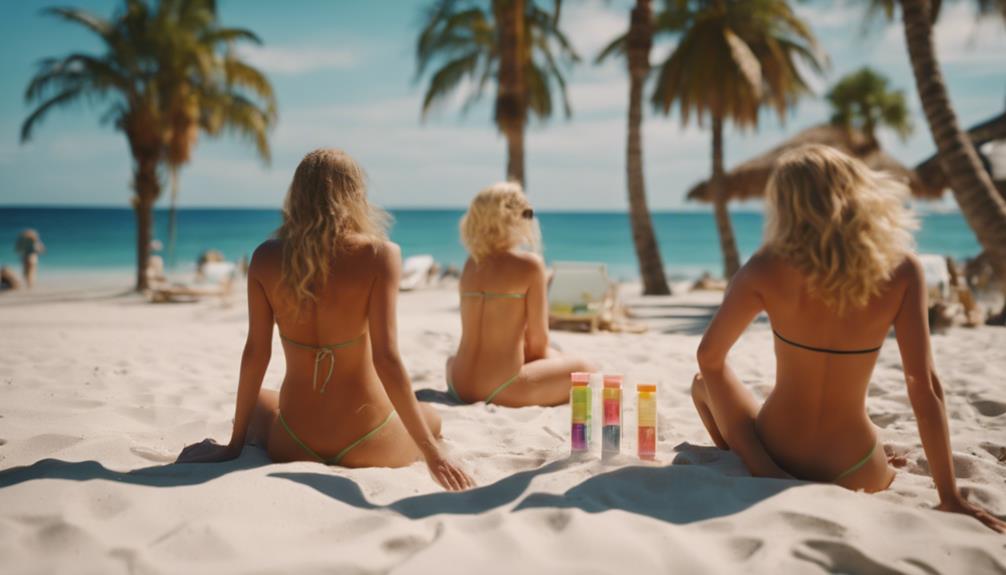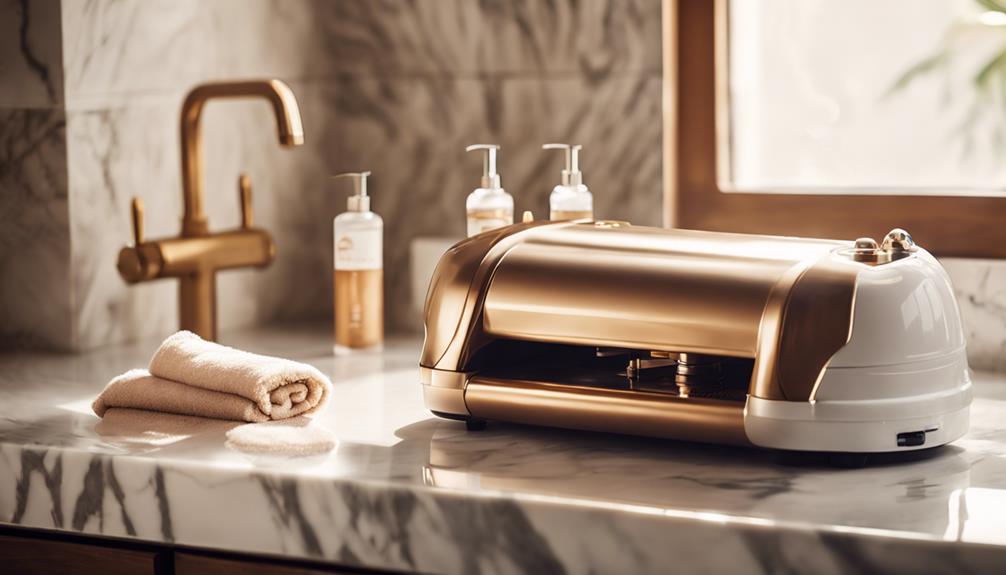Tanning pills have made a surprising comeback, leaving dermatologists shocked at their renewed popularity. These dietary supplements aim to change your skin color using ingredients like beta-carotene and lycopene. While they promise a bronzed look, they don't provide UV protection and come with health risks, especially those containing canthaxanthin, which can lead to serious side effects. As more consumers seek safer tanning options, the market for these pills grows. However, understanding potential dangers and exploring alternatives is essential for your skin health. Stick around to uncover the full story behind this tanning trend and what it means for you.
Key Takeaways
- Tanning pills, particularly those containing beta-carotene and lycopene, have seen a resurgence due to demand for safer tanning alternatives.
- Dermatologists express concern over the health risks of canthaxanthin, an unapproved ingredient linked to liver damage and vision issues.
- Social media trends and influencer endorsements contribute to the growing popularity of tanning pills among younger consumers.
- Tanning pills do not provide UV protection, increasing the risk of skin cancer and uneven pigmentation.
What Are Tanning Pills?
Tanning pills are dietary supplements that aim to change your skin color through active ingredients like beta-carotene and lycopene.
Beta-carotene can give your skin a yellow-orange hue, while lycopene may produce an orangey tone. Canthaxanthin is another ingredient known for its color-altering effects, but it's not FDA-approved for this purpose due to significant health risks.
While some users report satisfactory results, the effectiveness of tanning pills can vary widely from person to person. You might find that the changes in your skin tone are minimal or even unnatural-looking.
It's important to remember that these pills don't stimulate melanin production or provide any UV protection. This lack of protection can increase your risk of skin cancer, a concern often highlighted by dermatologists.
Before considering tanning pills, it's wise to consult a dermatologist to understand the potential implications for your health. They can provide guidance on safe tanning practices and help you weigh the pros and cons of these supplements.
Ultimately, it's vital to prioritize your skin's health over achieving a tan through dubious means.
How Tanning Pills Work

These pills alter your skin's pigmentation through active ingredients like beta-carotene, lycopene, and canthaxanthin, depositing color into your skin layers.
When you take tanning pills, beta-carotene converts to vitamin A, giving your skin a yellow-orange hue. Lycopene, sourced from tomatoes, can lead to an orangey skin tone. Canthaxanthin, a reddish-orange colorant, can accumulate in your body but requires high doses for visible effects. However, be cautious—canthaxanthin poses significant health risks, including potential organ damage.
Unlike traditional sun exposure, tanning pills don't stimulate melanin production, which is vital for your skin's natural protection against UV rays. This lack of melanin means your new skin pigmentation may appear artificial and could be uneven, depending on your metabolism and skin type.
Some users notice changes after consistent use, while others may not see the desired effect at all. Always consult a healthcare professional before starting any tanning pill regimen, as understanding the potential health risks is essential.
Active Ingredients Explained

Understanding the active ingredients in tanning pills reveals how they manipulate skin color, with beta-carotene, lycopene, and canthaxanthin playing essential roles. These ingredients can alter your skin tone, but they come with a mix of health benefits and potential unpleasant side effects.
- Beta-carotene: This ingredient converts to vitamin A in your body and can give your skin a yellow-orange hue. It's known for its antioxidant properties, which can support skin health, but too much can lead to an unnatural appearance.
- Lycopene: Found in tomatoes, lycopene can impart an orangey tone to your skin. While it may offer some health benefits, like reducing the risk of certain diseases, the color change mightn't be what you expect.
- Canthaxanthin: This orange dye isn't approved for pill use due to safety concerns, including potential organ damage. The accumulation of these carotenoids can lead to uneven pigmentation, especially in thicker skin areas like your palms and soles.
Each of these active ingredients can impact your skin in surprising ways, so it's important to be informed before trying tanning pills.
Effectiveness Compared to Tanning

When you compare tanning pills to a natural tan, you'll notice significant differences in color and skin health.
While tanning pills can change your skin tone through ingredients like beta-carotene, they often result in an orange hue rather than the golden glow you'd expect from UV exposure.
Plus, these pills don't provide the protective benefits of melanin, leaving your skin vulnerable.
Natural Tan Comparison
Tanning pills can change your skin color, but they don't produce the same protective effects or natural appearance as a real tan from sun exposure. While you might see a shift in your skin tone, it's important to understand the differences between tanning pills and natural tanning.
Melanin Production: Natural tanning stimulates melanin production in your skin, providing some level of UV protection. Tanning pills, on the other hand, primarily rely on canthaxanthin, which alters pigmentation without offering any defense against UV rays.
Skin Damage: Using tanning pills might lead to an orange hue and uneven pigmentation, especially on thicker skin areas like your palms. Without proper sun protection factor (SPF), you risk increased skin damage and potential long-term issues.
Natural Appearance: The color change from tanning pills doesn't replicate the complexity of a true tan. Dermatologists consistently highlight that while tanning pills can offer a temporary change, they can't replace the benefits of a natural tan achieved through responsible sun exposure and protective measures.
Ingredient Impact on Color
How do the ingredients in tanning pills compare to natural tanning methods regarding color effectiveness? Tanning pills typically contain carotenoids like canthaxanthin, which alter skin pigmentation. However, unlike UV exposure that stimulates melanin production for a natural tan, these pills don't trigger melanin synthesis. This difference means that users might experience an unnatural orange hue rather than a desirable bronze.
Here's a comparison of key factors:
| Factor | Tanning Pills | Natural Tanning |
|---|---|---|
| Active Ingredient | Canthaxanthin, carotenoids | UV exposure |
| Mechanism of Action | Alters skin pigmentation | Stimulates melanin production |
| Color Result | Often orange, uneven pigmentation | Natural bronze tones |
| Health Risks | Potential liver damage, retinal deposits | Generally low with moderation |
Due to the varying effectiveness based on individual metabolism and skin type, results can greatly differ. Some might achieve a deeper tint, while others could be left with an undesirable color. Therefore, it's essential to weigh the potential health risks against the desired look when considering tanning pills.
Safety Concerns to Consider

Several safety concerns arise with the use of tanning pills, particularly those containing canthaxanthin, due to their potential to cause serious health issues. Before you consider using these products, it's vital to understand the risks involved. Here are three key safety concerns to keep in mind:
- Liver Damage: Canthaxanthin has been linked to liver toxicity, which can lead to severe health complications. Regular use may put your liver at risk.
- Vision Issues: Canthaxanthin retinopathy can occur, resulting in crystalline deposits in the retina. This condition can impair your vision and lead to long-term eye problems.
- Lack of Regulation: The FDA hasn't approved tanning pills, meaning they often contain unlisted ingredients. This lack of oversight raises serious safety concerns about what you're actually consuming.
While you might be tempted to chase that sun-kissed glow, it's important to weigh these health risks against the benefits.
Tanning pills don't protect against UV radiation, further increasing your risk of skin cancer. Always prioritize your health and safety before making beauty choices.
Potential Side Effects

Considering the risks, using tanning pills can lead to a variety of potential side effects that may impact your health. Many of these pills, especially those containing canthaxanthin, can cause serious health issues. Here's a breakdown of some common side effects:
| Side Effect | Description | Health Impact |
|---|---|---|
| Eye Damage | Crystal deposits in the retina | Vision impairment |
| Gastrointestinal Issues | Cramping, diarrhea | Discomfort, dehydration |
| Skin Discoloration | Carotenemia, yellow-orange skin tone | Cosmetic concern |
Moreover, tanning pills don't offer any protection against UV radiation, which can heighten your risk of skin cancers. Long-term use remains largely unstudied, but some reports link these pills to severe conditions like aplastic anemia. Additionally, allergic reactions to ingredients can lead to hives or other skin irritations.
Before considering tanning pills, it's essential to weigh these potential side effects against your desire for a tanned appearance. Prioritizing your health should always come first.
Regulatory Status Overview

While weighing the risks of potential side effects, it's important to understand the regulatory status of tanning pills, which are classified as dietary supplements and lack pre-market approval from the FDA. This means that these products can hit the market without extensive safety evaluations.
Here are three key points to take into account:
- Post-Market Regulation: The FDA regulates tanning pills after they're already on the market, which can lead to safety concerns since they don't require prior approval.
- Ingredient Scrutiny: Many tanning pills contain canthaxanthin, a substance not approved by the FDA due to potential health risks, raising further alarm about what you're actually consuming.
- Lack of Oversight: Companies often don't notify the FDA when they sell these dietary supplements, resulting in unregulated products that may contain unlisted ingredients and misleading labels.
Given this landscape, it's vital to approach tanning pills with caution. The unregulated nature of these supplements can put you at risk, making it essential to stay informed about what you're putting into your body.
Consumer Trends in Tanning

You've probably noticed how social media influences your beauty choices, especially when it comes to tanning.
As demand for tanning pills grows, more brands are stepping up to meet your desire for a sun-kissed look without the harmful effects of UV exposure.
With safety awareness campaigns on the rise, it's essential to reflect on what these products really offer before you make a choice.
Social Media Influence
Social media's grip on beauty trends has made tanning pills a hot topic, especially among younger consumers enthusiastic for that perfect sun-kissed glow. Platforms like TikTok have amplified the appeal of these products, with influencers showcasing their results and promoting them as quick and convenient alternatives to traditional tanning methods. However, this surge in popularity raises significant questions about safety.
Here are three key points to reflect on:
- Influencer Impact: Influencers highlight their before-and-after looks, which can create unrealistic expectations. Their endorsements often overshadow the need for scientific validation.
- Safety Concerns: Dermatologists warn about the misinformation surrounding tanning pills. Many products remain unregulated, posing potential health risks that consumers may overlook.
- Beauty Standards: The trend reflects societal pressures for tanned skin, pushing you toward solutions that promise a glow without sun exposure, despite the potential dangers involved.
As you navigate the world of tanning pills, remember to weigh the opinions of dermatologists and prioritize your health first. Social media may be tempting, but informed choices are essential for your safety.
Market Demand Growth
The demand for tanning pills is skyrocketing as consumers increasingly seek convenient and safer alternatives to traditional tanning methods. With the rise of influencer marketing on platforms like TikTok, you're likely feeling the societal pressure to achieve that coveted tanned look. This shift has fueled market demand growth for tanning pills, mists, and sprays that promise skin tone enhancement without the risks associated with UV exposure.
Many consumers are turning to these products, believing they offer a safer alternative to tanning beds, which are linked to higher skin cancer risks. While the effectiveness of tanning pills may lack robust scientific backing, the allure of an easy solution is hard to resist.
As beauty standards evolve and discussions about skin tone diversity gain traction, brands are responding to your desire for safer and more effective tanning options. In this climate, it's no surprise that more people are gravitating towards tanning pills, driven by the need for convenience and safety.
As you explore these trends, consider how they align with your own beauty aspirations and health priorities.
Safety Awareness Campaigns
With the surge in popularity of tanning pills, safety awareness campaigns are increasingly important to educate consumers about the potential health risks associated with these products. While they may seem appealing, the lack of FDA approval raises significant concerns.
Here are three key points to reflect on:
- Health Risks: Many tanning pills, especially those containing canthaxanthin, can lead to serious side effects such as liver damage and vision problems. These risks far outweigh the temporary aesthetic benefits.
- Sunless Tanning Alternatives: Experts recommend opting for sunless tanning products containing dihydroxyacetone (DHA), which are FDA-approved and provide a safer option for achieving that bronzed look without the dangers of UV exposure.
- Educating Consumers: With influencer marketing glamorizing tanning pills on social media, it's vital that safety awareness campaigns reach consumers. You deserve to make informed choices about your skin health, prioritizing long-term safety over short-term appearance.
Alternatives to Tanning Pills

Topical self-tanning creams offer a safer way to achieve a bronzed look without the risks of tanning pills. These self-tanning products typically contain dihydroxyacetone (DHA), which interacts with your skin cells to create a natural-looking tan. Unlike tanning pills, there's no need to worry about harmful ingredients or potential side effects.
In addition to self-tanning creams, you can explore tanning mists, sprays, and foams. These options provide a quick application and temporary color that can easily be adjusted to your desired level of tan.
If you prefer to get some sun exposure, remember to use broad-spectrum sunscreen to protect your skin from UV damage while maintaining a healthy glow.
For those interested in innovative solutions, new products like sunscreen pills are in development. They aim to offer UV protection without the hassle of applying traditional sunscreen.
As consumers increasingly prioritize safety, it's important to check ingredient lists and select products free from potentially harmful substances. By choosing safer alternatives, you can enjoy a beautiful tan without compromising your skin health.
Where to Purchase Tanning Pills

Where can you find reliable tanning pills? It's crucial to know where to purchase tanning pills that are safe to take and approved by the FDA. Here are three trusted options to evaluate:
- Official Brand Websites: Many reputable brands sell their tanning pills directly online. This way, you can access detailed information about the ingredients in tanning pills and read customer reviews.
- Specialized Health Supplement Retailers: Look for online retailers that focus on health supplements. Verify that they provide transparency about the products they sell, including FDA approval and ingredient safety.
- Beauty and Wellness Stores: Local stores often carry tanning pills, but availability can differ. Check your nearby shops, and don't hesitate to ask staff about the safety and approval of the products.
Regardless of where you choose to purchase tanning pills, always verify the credibility of the seller.
Research the ingredients in tanning pills thoroughly to confirm they meet safety standards.
Frequently Asked Questions
Do Tanning Pills Actually Work?
Tanning pills claim to enhance skin color, but they often produce inconsistent results. You might see slight changes, but they don't offer a natural tan or protect against UV rays, posing health risks instead.
Is There a Tanning Pill That Works?
About 30% of users report uneven skin tone from tanning pills. While some claim effectiveness, most dermatologists warn they don't produce a natural tan and can pose serious health risks. Always prioritize safe sun exposure instead.
What Are the Side Effects of the Tanning Pill?
Tanning pills can cause serious side effects like eye damage, gastrointestinal issues, and skin discoloration. You might experience allergic reactions or long-term skin changes, emphasizing the risks involved in using these products.
What Supplements Help You Tan Better?
You might think supplements can enhance your tan, but most don't guarantee results. Instead, focus on safe options like self-tanning creams or sunless tanning products, which provide a more natural appearance without health risks.
Are Tanning Pills Safe for Nighttime Use Like Moon Tanning?
Tanning pills are not safe for nighttime use like moon tanning. The moon tanning phenomenon does not involve UV rays, so these pills won’t work at night. It’s crucial to practice safe tanning habits and use sunscreen to protect your skin, regardless of the time or method used.
Conclusion
As you step into the sun-kissed world of tanning pills, imagine a golden glow enveloping you without the harsh UV rays.
While these new formulations promise a bronzed beauty, remember to weigh the risks and benefits.
Your skin deserves the best care, and with informed choices, you can shine brightly and safely.
So, whether you choose to embrace the sun or opt for a bottle, let your confidence radiate like a summer sunset.









